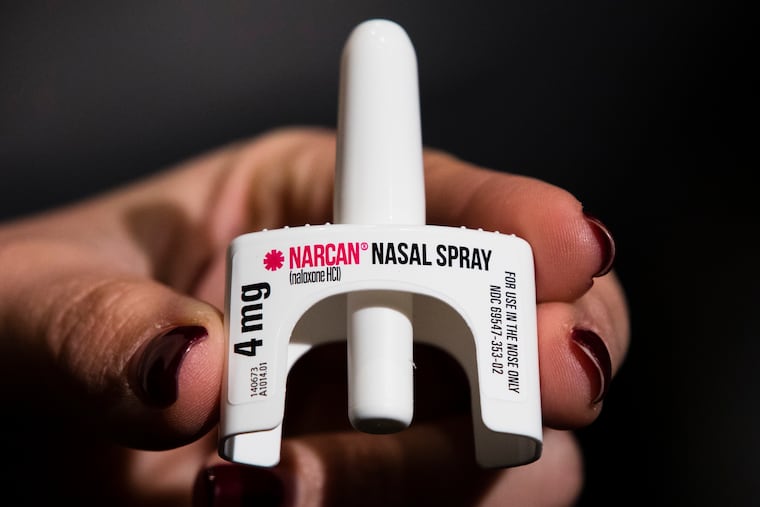Overdose deaths are rising dramatically among Black Philadelphians, new data show
In 2022, Black men saw the highest number of overdose fatalities among any demographic group in the city.

Fatal overdoses among Philadelphians are higher than ever. And drug deaths are rising dramatically among Black and Hispanic Philadelphians, even as fewer white residents are dying of overdoses, city officials said in a wide-ranging report on overdose deaths in 2022.
Between 2018 and 2022, health officials say, fatal overdoses among Black Philadelphians nearly doubled, from 347 to 649 deaths. Deaths among Hispanic Philadelphians increased by 43%. In the same time period, deaths among white residents decreased by 12%.
In 2022, Black men saw the highest number of overdose fatalities among any demographic group in the city.
“We’re at a point now where it definitely is a major crisis,” said Andrew Best, the director of the Substance Use Prevention and Harm Reduction Division at the city health department.
Jose de Marco, an activist with ACT UP Philadelphia, an AIDS advocacy group that also promotes strategies to reduce the harmful effects of drug use, said the scale of loss was devastating.
“I can’t recall how many overdoses I’ve personally reversed,” he said. “I’ve seen people die in my arms. I’ve lost partners to this drug. It’s the reality of it. And as with most racial and social injustices, it’s always Black and Latinx people that are going to rise to the top.”
Best said a number of factors are behind Philadelphia’s 1,413 overdose deaths in 2022, a record. In 2018, 1,116 Philadelphians died of overdoses.
Factors behind the rise
While opioids, mostly the synthetic opioid fentanyl, were involved in 83% of drug deaths last year, more than half of the overdose deaths involved both opioids and stimulants like cocaine and methamphetamine.
It’s unclear whether people are deliberately using stimulants and opioids at the same time, or whether they unintentionally consumed them mixed together.
Opioid-stimulant deaths were particularly prevalent among Black and Hispanic victims: The number of opioid-stimulant deaths increased by 146% among Black residents between 2018 and 2022, and by 81% among Hispanic residents. By contrast, opioid-stimulant deaths among white residents increased by only 7%.
In the same time period, deaths involving only stimulants increased among Black and white residents, but Hispanic residents saw a slight decrease. Meanwhile, deaths involving only opioids increased slightly among Black and Hispanic residents and decreased among white residents.
Older Philadelphians are also dying from overdoses more often: The median age of overdose victims in Philadelphia was 48 in 2022, up from 43.5 in 2018.
Best said that some stimulant-related deaths in 2022 may have occurred among older drug users who suffer from other health issues. The city’s contaminated drug supply is also to blame for the rise in deaths, he said.
“Those are our two main focuses right now, and we’re learning about what that means,” he said.
Most of the drugs sold as opioids on the street are likely illicit fentanyl, the powerful synthetic opioid that has replaced most of the city’s heroin. Fentanyl is also usually now combined with xylazine, an animal sedative not approved for human use that causes hard-to-reverse overdoses and serious wounds. (Xylazine was present in 34% of fatal overdoses in 2022, in almost every case combined with fentanyl.)
Researchers who test Philadelphia’s street drugs have also found fentanyl in some samples of drugs sold as cocaine.
Prevention efforts
It’s crucial, Best said, for health officials to understand the dangers of the city’s drug supply, and to communicate those dangers to people using drugs. The city regularly tests street drugs through a partnership with a local forensic lab, and is also working to increase outreach in neighborhoods that are seeing rises in overdoses. While the 19134 zip code, which includes Kensington, saw 193 overdose deaths in 2022, the highest of any zip code in the city, neighborhoods in North and West Philadelphia also saw increases.
Later this month, the city’s Overdose Response Unit will launch a door-knocking campaign in North Philadelphia, handing out resources for overdose prevention, including the overdose treatment drug naloxone, to as many residents as possible — not just people who use drugs.
“Our past efforts around overdose prevention and education required people to raise their hand,” said the unit’s director, Noelle Foizen. “Now, we’re going directly to people’s homes without them having to raise their hands to say they’re interested in learning more. We want to create this collective responsibility.”
More than half of the $650,000 effort is being covered by opioid lawsuit settlement funds, she said.
Smaller efforts in the neighborhood over the last year have already proved beneficial — especially, Best said, when residents conduct outreach in their own communities. “We’ve been strategic in hiring people with lived experience and also people from these communities: someone that you know, someone who represents the demographics that are being affected,” he said.
ACT UP, too, is working to organize a door-knocking campaign to promote harm-reduction measures.
“I’m hoping this will start to galvanize people. Drug addiction is hard for people to talk about,” de Marco said. “But we can make people understand harm reduction is about keeping people alive — dead people don’t recover.”
He added that he was frustrated that City Council had recently voted to ban supervised drug consumption sites, where people can use drugs under medical supervision and be revived if they overdose. Best and Foizen declined to comment specifically on that vote. But, they said, they support any effort to stem the tide of deaths.
“The health department supports any intervention that has been proven to save lives, and we’ll continue to find new, innovative ways to reach people,” Best said.